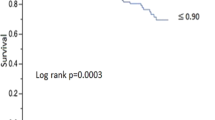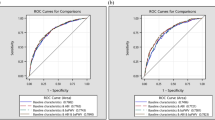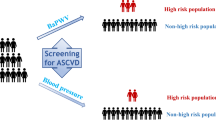Abstract
The aim of this study was to evaluate the risk factors of peripheral arterial disease (PAD) and the relationship between ankle brachial index (ABI) and mortality from all-cause and cardiovascular disease (CVD) in Chinese patients with hypertension. The ABI cohort Study was designed to investigate risk factors of PAD and the relationship between ABI and mortality from all-cause and CVD in Chinese patients. ABI was identified at baseline by measuring systolic pressure at bilateral brachial and tibial arteries. Mortality surveillance was completed from November 2005 to January 2006. Among 3047 participants with hypertension at baseline, 839 (27.5%) were in the low-ABI group. Older age, female gender, higher serum level of triglycerides, lower serum level of high-density lipoprotein, a history of diabetes and a history of smoking were associated with low ABI. During the 13-month follow-up, there were 252 deaths, of which 100 died of CVD. Low ABI was associated with mortality from all-cause and CVD, whose adjusted relative risk was 1.619 (95% confidence interval 1.190–2.203) and 2.454 (1.531–3.933), respectively, in Cox regression models. The survival rate was significantly lower in the low-ABI group than in the normal-ABI group. This study demonstrated that low ABI was independently associated with a high risk of all-cause and CVD mortality in Chinese patients with hypertension. ABI should be promoted as an ideal tool to predict mortality in diabetic patients.
This is a preview of subscription content, access via your institution
Access options
Subscribe to this journal
Receive 12 digital issues and online access to articles
$119.00 per year
only $9.92 per issue
Buy this article
- Purchase on Springer Link
- Instant access to full article PDF
Prices may be subject to local taxes which are calculated during checkout



Similar content being viewed by others
References
Hiatt WR . Medical treatment of peripheral arterial disease and claudication. N Engl J Med 2001; 344: 1608–1621.
Murabito JM, Evans JC, Nieto K, Larson MG, Levy D, Wilson PW . Prevalence and clinical correlates of peripheral arterial disease in the Framingham Offspring Study. Am Heart J 2002; 143: 961–965.
Novo S . Classification, epidemiology, risk factors, and natural history of peripheral arterial disease. Diabetes Obes Metab 2002; 4: S1–S6.
Meijer WT, Hoes AW, Rutgers D, Bots ML, Hofman A, Grobbee DE . Perpheral arterial disease in the elderly: the Rotterdam Study. Arterioscler Thromb Vasc Biol 1998; 18: 185–192.
Stoffers HEJH, Rinkens PELM, Kester ADM, Kaiser V, Knottnerus JA . The prevalence of asymptomatic and unrecognized peripheral arterial occlusive disease. Int J Epidemiol 1996; 25: 282–290.
Cardiovascular Health Study (CHS) Collaborative Research Group. Ankle-arm index as a marker of atherosclerosis in the Cardiovascular Health Study. Circulation 1993; 88: 837–845.
Hirsch AT, Criqui MH, Treat-Jacobson D, Regensteiner JG, Creager MA, Olin JW et al. Peripheral arterial diserse detection, awareness, and treatment in primary care. JAMA 2001; 286: 1317–1324.
McDermott MM, Kerwin DR, Liu K, Martin GJ, O'Brien E, Kaplan H et al. Prevalence and significance of unrecognized lower extremity peripheral arterial disease in general medicine practice. J Gen Intern Med 2001; 16: 384–390.
McKenna M, Wolfson S, Kuller L . The ratio of ankle and arm arterial pressure as an independent predictor of mortality. Atherosclerosis 1991; 87: 119–128.
McDermott MM, Feinglass J, Slavensky R, Pearce WH . The ankle-brachial index as a predictor of survival in patients with peripheral vascular disease. J Gen Intern Med 1994; 9: 445–449.
Newman AB, Shemanski L, Manolio TA, Cushman M, Mittelmark M, Polak JF et al. Ankle-arm index as a predictor of cardiovascular disease and mortality in the Cardiovascular Health Study: the Cardiovascular Health Study Group. Arterioscler Thromb Vasc Biol 1999; 19: 538–545.
O'Donnell CJ, Ridker PM, Glynn RJ, Berger K, Ajani U, Manson JE et al. Hypertension and borderline isolated systolic hypertension increase risks of cardiovascular disease and mortality in male physicians. Circulation. 1997; 95: 1132–1137.
Li J, Buaijiaer HS, Yu JM, Wang J, Hu DY . Prevalence of peripheral arterial disease and risk factors for the low and high ankle-brachial index in Chinese patients with type 2 diabetes. J Health Sci 2006; 52: 97–102.
Criqui MH, Fronek A, Barrett-Connor E, Klauber MR, Gabriel S, Goodman D . The prevalence of peripheral arterial disease in a defined population. Circulation 1985; 71: 510–515.
Pomrehn P, Duncan B, Weissfeld L, Wallace RB, Bames R, Heiss G et al. The association of dyslipoproteinemia with symptoms and signs of peripheral arterial disease: The Lipid Research Clinics Program Prevalence Study. Circulation 1986; 73: 1100–1107.
Hiatt WR, Marshall JA, Baxter J, Sandoval R, Hildebrandt W, Kahn LR et al. Diagnostic methods for peripheral arterial disease in the San Luis Valley Diabetes Study. J Clin Epidemiol 1990; 43: 597–606.
Helaine ER, Robert SL, Mary MM, Richard BD, Kristina LJ, Richard RF et al. Relationship of high and low Ankle brachial index to all-cause and cardiovascular disease mortality: The strong heart study. Circulation 2004; 109: 733–739.
Carter SA . The role of pressure measurements in vascular disease. In: Bernstein EF (ed). Non-Invasive Diagnostic Techniques in Vascular Disease. St Louis: Mosby, 1985, pp 513–544.
Fabsitz RR, Sidawy AN, Go O, Lee ET, Welty TK, Devereux RB et al. Prevalence of peripheral arterial disease and associates risk factors in American Indians: the Strong Heart Study. Am J Epidemiol 1999; 149: 330–338.
The American College of Cardiology foundation and the American Heart Association. ACC/AHA guidelines for the management of patients with peripheral arterial disease. 2005.
Leng GC, Lee AJ, Fowkes FG, Whiteman M, Dunbar J, Housley E et al. Incidence, natural history and cardiovascular events in symptomatic and asymptomatic peripheral arterial disease in the general population. Int J Epidemiol 1996; 25: 1172–1181.
Hooi JD, Kester AD, Stoffers HE, Overdijk MM, van Ree JW, Knottnerus JA . Incidence of and risk factors for asymptomatic peripheral arterial occlusive disease: a longitudinal study. Am J Epidemiol 2001; 153: 666–672.
Leng GC, Fowkes FG, Lee AJ, Dunbar J, Houseley E, Ruckley CV . Use of ankle brachial pressure index to predict cardiovascular events and death: a cohort study. BMJ 1996; 313: 1440–1444.
Author information
Authors and Affiliations
Corresponding author
Rights and permissions
About this article
Cite this article
Luo, Y., Li, J., Xin, Y. et al. Risk factors of peripheral arterial disease and relationship between low ankle brachial index and mortality from all-cause and cardiovascular disease in Chinese patients with hypertension. J Hum Hypertens 21, 461–466 (2007). https://doi.org/10.1038/sj.jhh.1002177
Received:
Revised:
Accepted:
Published:
Issue Date:
DOI: https://doi.org/10.1038/sj.jhh.1002177
Keywords
This article is cited by
-
Different associations of general and abdominal obesity with upper and lower extremity artery disease among a community population in China
Nutrition & Metabolism (2023)
-
Risk factors of peripheral arterial disease: a case control study in Sri Lanka
BMC Research Notes (2016)
-
Clustering of target organ damage increases mortality after acute coronary syndromes in patients with arterial hypertension
Journal of Human Hypertension (2011)
-
Hypertension and peripheral arterial disease
Journal of Human Hypertension (2009)
-
Peripheral artery disease and hypertension: the relation between ankle–brachial index and mortality
Journal of Human Hypertension (2007)



